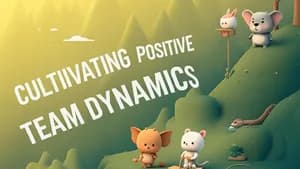Introduction: The Power of Teamwork
In today's collaborative learning environments, whether it's a group project, a study group, or even a family working together on a home project, effective communication is the cornerstone of success. It's not enough to simply show up and contribute; you need to actively participate in building a strong team dynamic. This involves understanding and utilizing proactive communication strategies to avoid misunderstandings and foster unity. This article will explore how proactive communication, including regular check-ins and open forums, can prevent misunderstandings and build a stronger sense of unity within your team. We'll delve into the importance of active listening and clear, concise messaging for effective collaboration. I've seen firsthand how teams that master these skills consistently outperform those that don't, producing higher-quality work and fostering a more positive learning environment.
Regular Check-ins: Staying on Track
One of the most effective ways to foster unity and prevent problems is through regular check-ins. These don't have to be formal meetings; they can be short, informal chats, perhaps at the beginning or end of a study session, or even a quick text message exchange. The key is consistency. Imagine you're working on a science project with your friends. Instead of waiting until the last minute, set aside a few minutes every couple of days to discuss progress, identify roadblocks, and divide tasks. This approach prevents small issues from escalating into major conflicts. For example, if one team member is falling behind, you can address it proactively and offer support instead of letting resentment build. One particularly effective technique I've found is to create a shared online document to track tasks, progress, and deadlines. This visual representation gives everyone a clear picture of where the project stands and minimizes confusion.
Open Forums: A Space for Honest Dialogue
Creating a safe and open space for communication is crucial for building team unity. This involves encouraging open dialogue where every member feels comfortable sharing their ideas, concerns, and even disagreements. Avoid using judgmental language, ensuring everyone feels heard and respected. Remember that a diverse set of perspectives enriches the overall output. When tackling difficult problems, I've found brainstorming sessions to be remarkably useful. Everyone gets an equal chance to contribute. One team I worked with used a simple 'round-robin' approach, where each person shared one idea at a time, guaranteeing everyone got a chance to speak. Avoid interrupting or dismissing opinions; active listening is key to building trust.
Active Listening: The Cornerstone of Understanding
Active listening is more than simply hearing; it's about truly understanding the other person's perspective. It involves paying attention to their words, their body language, and the overall context of the conversation. Paraphrasing what you hear is a powerful technique; it not only confirms your understanding but shows the speaker that you're actively engaged. I've seen many students struggle because they interrupt or dismiss others' ideas before really understanding them. Always try to summarize a teammate's point before providing your response, ensuring that you grasp their perspective completely. For example, you could say, 'So, if I understand correctly, you're saying...'. Then summarize the point before adding your response. This eliminates misinterpretations and fosters a collaborative environment.
Clear and Concise Messaging: Avoiding Misunderstandings
Clear and concise communication is essential for preventing misunderstandings and ensuring everyone is on the same page. When communicating, avoid jargon and ambiguity; use simple, straightforward language. Always be specific about deadlines, expectations, and responsibilities. If you're using any tools or platforms for group communication, make sure everyone is proficient in using them. I've often noticed that unclear communication leads to confusion, missed deadlines, and conflict. Before sending an important message, take a moment to proofread it to eliminate any possible ambiguity. Similarly, before beginning a task, always ensure that you understand the precise instructions and clarify any uncertainties immediately. Use visuals (diagrams, flow charts, etc.) to complement your written or verbal instructions to support clarity. This reduces miscommunication and ensures everyone has a shared vision.
Conclusion: Cultivating a Unified Team
Building a unified team takes consistent effort and a commitment to proactive communication. By implementing regular check-ins, creating open forums, practicing active listening, and ensuring clear and concise messaging, you can significantly enhance teamwork, foster a positive learning experience, and achieve greater success. Remember, effective communication is a skill that improves with practice. By incorporating these techniques, you will not only complete your projects effectively but also strengthen your relationships and build valuable skills that will benefit you throughout your life. I have witnessed countless students, families, and groups who, once they mastered these simple strategies, dramatically improved the quality of their work and the strength of their bonds. So, start practicing these strategies today, and experience the power of proactive communication in building a truly unified and successful team. Your collective effort will prove far more successful with the strength of unity.

